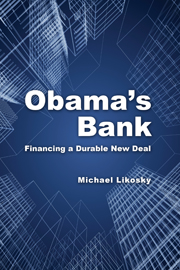Earlier this week, President Obama offered up a $50 billion program for infrastructure, how about a national bank for infrastructure?
The story "Obama's Infrastructure Plan: More Cash Could Hit the Road: The President aims to spend $50 billion on transportation infrastructure" from Bloomberg Business Week explains the proposal. The article, "Obama unveils $50B road, rail plan " from the Norfolk Virginian-Pilot gets down to the details:
In his speech to the Milwaukee Area Labor Council, Obama laid out the goals of his new program: Rebuild 150,000 miles of roads; construct and maintain 4,000 miles of rail, enough to go coast to coast; and restore 150 miles of runways, while putting in a next-generation air traffic control system to reduce travel time and delays.
This editorial, "Stimulus, shmimulus," from the Baltimore Sun makes a good point that $50 billion is only $1 billion per state, and that a single infrastructure project such as the Inter County Connector costs $2.5 billion. Plus, the program is dedicating a significant sum towards railroad track improvements--a good thing of course, but a further reduction of the money made available to each state.
From the Sun editorial:
What Mr. Obama is proposing is not some wild-eyed liberal spending scheme but the kind of basic investment that Washington should be making whether today's unemployment is 9.8 percent or 2.8 percent. The country needs roads, bridges, rail lines and runways in order to, as the president observed, compete in the 21st century global economy.
What's $50 billion? Barely a start. The country has not kept up with these basic needs for years. The transportation bill — the nation's six-year road map for transportation spending — was allowed to expire this year. But the latest version being considered by Congress calls for $50 billion to be spent each year. Even that, many experts argue, would merely keep the country at the status quo.
To think of $50 billion as some extravagance is like treating roof shingles as a luxury item. Stop replacing them and a homeowner will quickly discover that the damage — and cost — of inaction is far worse than any savings afforded by staying pat.

After all, the Report Card on Infrastructure from the American Society of Civil Engineers estimates the need over the next 5 years for infrastructure improvement at $2.2 Trillion dollars, or 44 times larger than the recently announced program.
From the promotional flyer:
The Obama administration aims to lay a sound foundation for growth by investing in high-speed rail, clean energy, information technology, drinking water, and other vital infrastructures. The idea is to partner with the private sector to produce these public goods. An Obama government bank will direct these investments, making project decisions based on the merits of each project, not on politics. This approach has been a cornerstone of U.S. foreign policy for several decades. In fact, our government-led reinvestment in America is modeled explicitly on international public banks and partnerships. However, although this foreign commercial policy is well-established with many successes, it has also been deservedly controversial and divisive. This book describes the international experience, drawing lessons on how the Obama Bank can forge partnerships to promote a durable twenty-first-century New Deal.
The first book to explain Obama’s economic philosophy:
• Describes Obama’s plans to finance a durable ‘new’ New Deal
• Provides a roadmap for how our government can partner with banks to rebuild our infrastructure and put Americans back to work
• Explains Obama’s Infrastructure Bank, where it came from and how to make it work for America
Labels: infrastructure, public finance and spending, transportation infrastructure



0 Comments:
Post a Comment
<< Home